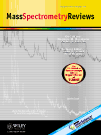Mass spectrometry (MS) is an analytical technique that is used to measure the mass-to-charge ratio of ions. The results are presented as a mass spectrum, a plot of intensity as a function of the mass-to-charge ratio. Mass spectrometry is used in many different fields and is applied to pure samples as well as complex mixtures.

An ion source is a device that creates atomic and molecular ions. Ion sources are used to form ions for mass spectrometers, optical emission spectrometers, particle accelerators, ion implanters and ion engines.
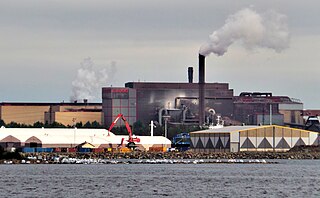
Environmental chemistry is the scientific study of the chemical and biochemical phenomena that occur in natural places. It should not be confused with green chemistry, which seeks to reduce potential pollution at its source. It can be defined as the study of the sources, reactions, transport, effects, and fates of chemical species in the air, soil, and water environments; and the effect of human activity and biological activity on these. Environmental chemistry is an interdisciplinary science that includes atmospheric, aquatic and soil chemistry, as well as heavily relying on analytical chemistry and being related to environmental and other areas of science.
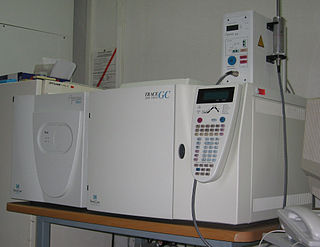
Gas chromatography–mass spectrometry (GC-MS) is an analytical method that combines the features of gas-chromatography and mass spectrometry to identify different substances within a test sample. Applications of GC-MS include drug detection, fire investigation, environmental analysis, explosives investigation, and identification of unknown samples, including that of material samples obtained from planet Mars during probe missions as early as the 1970s. GC-MS can also be used in airport security to detect substances in luggage or on human beings. Additionally, it can identify trace elements in materials that were previously thought to have disintegrated beyond identification. Like liquid chromatography–mass spectrometry, it allows analysis and detection even of tiny amounts of a substance.

A quadrupole ion trap or paul trap is a type of ion trap that uses dynamic electric fields to trap charged particles. They are also called radio frequency (RF) traps or Paul traps in honor of Wolfgang Paul, who invented the device and shared the Nobel Prize in Physics in 1989 for this work. It is used as a component of a mass spectrometer or a trapped ion quantum computer.
The thomson is a unit that has appeared infrequently in scientific literature relating to the field of mass spectrometry as a unit of mass-to-charge ratio. The unit was proposed by Cooks and Rockwood naming it in honour of J. J. Thomson who measured the mass-to-charge ratio of electrons and ions.
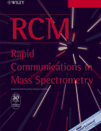
Rapid Communications in Mass Spectrometry (RCM) is a biweekly peer-reviewed scientific journal published since 1987 by John Wiley & Sons. It covers research on all aspects of mass spectrometry. According to the Journal Citation Reports, the journal has a 2020 impact factor of 2.419.
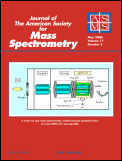
The Journal of the American Society for Mass Spectrometry is a monthly peer-reviewed scientific journal published by ACS Publications since 2020. From 2011 to 2019 it was published by Springer Science+Business Media and prior to that by Elsevier. It is the official publication of the American Society for Mass Spectrometry and freely available to members. The journal covers all aspects of mass spectrometry.
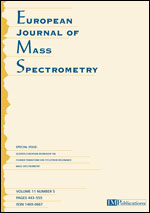
The European Journal of Mass Spectrometry is a peer-reviewed scientific journal covering all areas of mass spectrometry. It is published by SAGE Publishing and the editor-in-chief is Jürgen Grotemeyer.

The International Journal of Mass Spectrometry is a monthly peer-reviewed scientific journal covering all aspects of mass spectrometry, including instrumentation and applications in biology, chemistry, geology, and physics. It was established in 1968 as the International Journal of Mass Spectrometry and Ion Physics and was renamed International Journal of Mass Spectrometry and Ion Processes in 1983, before obtaining its current title in 1998. It is published by Elsevier and the editors-in-chief are Julia Laskin and Zheng Ouyang.
X-Ray Spectrometry is a bimonthly peer-reviewed scientific journal established in 1972 and published by John Wiley & Sons. It covers the theory and application of X-ray spectrometry. The current editor-in-chiefs are Johan Boman and Liqiang Luo.

Pyrolysis–gas chromatography–mass spectrometry is a method of chemical analysis in which the sample is heated to decomposition to produce smaller molecules that are separated by gas chromatography and detected using mass spectrometry.

Spark ionization is a method used to produce gas phase ions from a solid sample. The prepared solid sample is vaporized and partially ionized by an intermittent discharge or spark. This technique is primarily used in the field of mass spectrometry. When incorporated with a mass spectrometer the complete instrument is referred to as a spark ionization mass spectrometer or as a spark source mass spectrometer (SSMS).

The mass recorded by a mass spectrometer can refer to different physical quantities depending on the characteristics of the instrument and the manner in which the mass spectrum is displayed.
Michael L. Gross is Professor of Chemistry, Medicine, and Immunology, at Washington University in St. Louis. He was formerly Professor of Chemistry at the University of Nebraska-Lincoln from 1968–1994. He is recognized for his contributions to the field of mass spectrometry and ion chemistry. He is credited with the discovery of distonic ions, chemical species containing a radical and an ionic site on different atoms of the same molecule.

JWH-307 is an analgesic drug used in scientific research, which acts as a cannabinoid agonist at both the CB1 and CB2 receptors. It is somewhat selective for the CB2 subtype, with a Ki of 7.7 nM at CB1 vs 3.3 nM at CB2. It was discovered by, and named after, John W. Huffman. JWH-307 was detected as an ingredient in synthetic cannabis smoking blends in 2012, initially in Germany.
Meteoritics & Planetary Science is a monthly peer-reviewed scientific journal published by Wiley-Blackwell on behalf of the Meteoritical Society. It specialises in the fields of meteoritics and planetary science.

Instrumental analysis is a field of analytical chemistry that investigates analytes using scientific instruments.
Kevin Downard is a British - Australian academic scientist whose research specialises in the improving responses to infectious disease through the application and development of mass spectrometry and other molecular approaches in the life and medical sciences. Downard has 35 years of experience in the field and has written over 140 lead-author scientific peer-reviewed journal publications, over 150 conference proceedings, and two books including a textbook for the Royal Society of Chemistry and the first book to be published on the role of mass spectrometry in the study of protein interactions.
ChemWindow is a chemical structure drawing molecule editor and publishing program now published by John Wiley & Sons as of 2020, originally developed by Bio-Rad Laboratories, Inc. It was first developed by SoftShell International in the 1990s. Bio-Rad acquired this technology in 1996 and eventually made it part of their KnowItAll software product line, offering a specific ChemWindow edition of their software for structure drawing and publishing. They have also incorporated ChemWindow structure drawing components into their KnowItAll spectroscopy software packages with their DrawIt, ReportIt, and MineIt tools.
